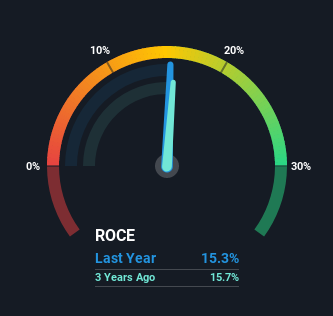Investors Met With Slowing Returns on Capital At Criteo (NASDAQ:CRTO)
Finding a business that has the potential to grow substantially is not easy, but it is possible if we look at a few key financial metrics. Ideally, a business will show two trends; firstly a growing return on capital employed (ROCE) and secondly, an increasing amount of capital employed. Put simply, these types of businesses are compounding machines, meaning they are continually reinvesting their earnings at ever-higher rates of return. That's why when we briefly looked at Criteo's (NASDAQ:CRTO) ROCE trend, we were pretty happy with what we saw.
What is Return On Capital Employed (ROCE)?
Just to clarify if you're unsure, ROCE is a metric for evaluating how much pre-tax income (in percentage terms) a company earns on the capital invested in its business. To calculate this metric for Criteo, this is the formula:
Return on Capital Employed = Earnings Before Interest and Tax (EBIT) ÷ (Total Assets - Current Liabilities)
0.15 = US$194m ÷ (US$1.8b - US$550m) (Based on the trailing twelve months to September 2021).
Therefore, Criteo has an ROCE of 15%. In absolute terms, that's a satisfactory return, but compared to the Media industry average of 9.1% it's much better.
See our latest analysis for Criteo
In the above chart we have measured Criteo's prior ROCE against its prior performance, but the future is arguably more important. If you'd like, you can check out the forecasts from the analysts covering Criteo here for free.
So How Is Criteo's ROCE Trending?
While the returns on capital are good, they haven't moved much. Over the past five years, ROCE has remained relatively flat at around 15% and the business has deployed 114% more capital into its operations. 15% is a pretty standard return, and it provides some comfort knowing that Criteo has consistently earned this amount. Stable returns in this ballpark can be unexciting, but if they can be maintained over the long run, they often provide nice rewards to shareholders.
The Key Takeaway
To sum it up, Criteo has simply been reinvesting capital steadily, at those decent rates of return. However, over the last five years, the stock hasn't provided much growth to shareholders in the way of total returns. That's why we think it'd be worthwhile to look further into this stock given the fundamentals are appealing.
If you'd like to know about the risks facing Criteo, we've discovered 1 warning sign that you should be aware of.
If you want to search for solid companies with great earnings, check out this free list of companies with good balance sheets and impressive returns on equity.
Have feedback on this article? Concerned about the content? Get in touch with us directly. Alternatively, email editorial-team (at) simplywallst.com.
This article by Simply Wall St is general in nature. We provide commentary based on historical data and analyst forecasts only using an unbiased methodology and our articles are not intended to be financial advice. It does not constitute a recommendation to buy or sell any stock, and does not take account of your objectives, or your financial situation. We aim to bring you long-term focused analysis driven by fundamental data. Note that our analysis may not factor in the latest price-sensitive company announcements or qualitative material. Simply Wall St has no position in any stocks mentioned.

 Yahoo Finance
Yahoo Finance 
